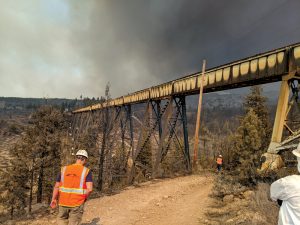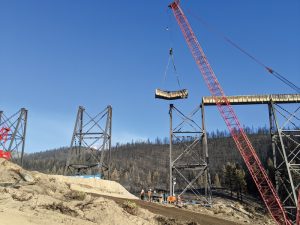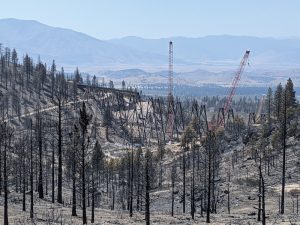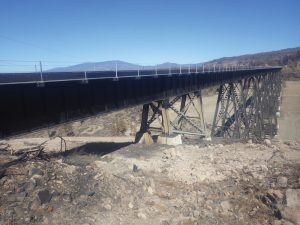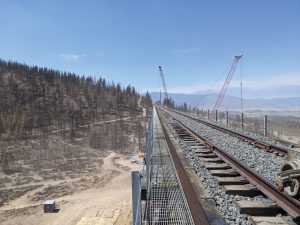Solution: Heat Straightening
The Lava Fire, one of the largest wildfires to scorch California in 2021, burned over 26,000 acres and prompted evacuations of at least 8,000 residents. Sparked by a lightning strike, the fire burned for just over two months around the wooded slopes of Mt. Shasta. The extensive fire heavily damaged multiple structures, including Union Pacific Railroad’s Dry Canyon Bridge and nine miles of track near Weed, California.
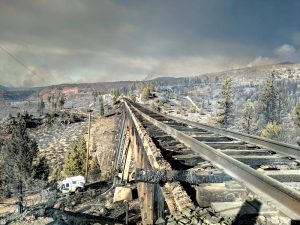
On June 28, 2021, the Dry Canyon bridge, which stands 150 feet tall and spans approximately 1,140 feet across a remote scenic valley, was closed due to the damage. While still combatting the fire in late June, Union Pacific Railroad Company (UPRR) engaged Modjeski and Masters (M&M) to assess the damage and recommend repairs to the steel-girded bridge.
The bridge, constructed in 1926, has 19 spans that vary in length. The spans are 70 feet 4 inches long from Abutment 1 to Bent 2 and Bent 19 to Abutment 20, 80 feet long for odd-numbered spans 3 through 17, and 40 feet long for even-numbered spans 2 through 18. The deck is comprised of a ballast deck with a timber ballast pan and curb. The superstructure also consists of steel girders supported by steel bents forming towers founded atop concrete pedestals. Unfortunately, the closely spaced ballast pan timbers and track ties made the bridge vulnerable to wildfires.
The first goal was to understand the extent of the damage and degree to which each steel span was deformed. M&M established three categories of damage to assess each steel deck plate girder. The categories were:
- Category One – The span was generally straight with minor distortions or was unaffected.
- Category Two – The span was noticeably deformed and distorted but within allowable limits for heat straightening.
- Category Three – The span was severely deformed and outside of the limits for heat straightening or would be uneconomical to repair and would need to be replaced.
During the inspection, the team reviewed the external physical damage to the girders on each span, along with the cross-frame and lateral members. The team then reviewed the fitness and structural integrity of the fire-exposed steel by looking at the steel type and grade and looking for heavy pitting, heavy dark grayscale, and any remnants of the original lead-based paint. These were signs that the metal had reached the limit of the transformation temperature.
Following the assessment, M&M concluded that all 19 spans needed to be repaired or replaced. Nine 40-foot-long (12.2m) spans met the criteria for Category Three and were replaced with safety stock spans of similar size. In contrast, the remaining spans fell into Category Two and were deemed salvageable through heat straightening.
Fundamentals of Heat Straightening
Heat straightening is a relatively uncommon but effective and efficient tool for repairing damaged steel members. However, as much as science, there is an art to heat straightening.
Heating techniques to shape or straighten structural steel draw their origins from the initial days of welding. During that time, it was discovered that the heat from welding during the fabrication of steel members caused distortions that followed a regular pattern. This occurrence spawned the idea of using carefully planned heating techniques to reverse the distortions caused by welding and other damage.
Heat straightening is not always an appropriate repair method, and its use must be considered in combination with the level of damage observed, the steel type, the economics of replacement versus repair, and the specific member damaged. Research has shown that heat straightening is a viable option without significantly affecting the material properties of mild steel for strain ratios of 100 or less. Additionally, the number of damage and repair cycles affects the steel’s material properties. Damaged areas should not be heat straightened more than two times.
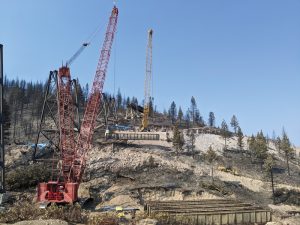
The heat straightening procedure used in this project is a controlled application of heat in planned and specific patterns to damaged regions of the steel in repetitive heating and cooling cycles to gradually straighten the damaged material. Straightening the steel relies primarily on internal forces to produce upset during the heating phase and contraction during the cooling phase with external restraints to aid the work. The heating and cooling phases produce a thermal gradient with each cycle, leading to a gradual straightening or shaping trend. As the heat is applied, the temperature decreases through the thickness of the material. The cooled material ahead of the heated area constrains thermal expansion. Because of the thermal gradient at the heated location, more upsetting occurs on the hotter side of the plate. During cooling, the hotter side contracts more than the cooler side, creating disproportional movement on either side of the plate. External forces can be applied to magnify the movements to aid in this process.
Several conditions must be met to perform heat straightening safely and effectively:
- The applied temperature must not exceed the transformation temperature of approximately 1300 degrees Fahrenheit.
- Stress produced by any applied external forces does not exceed the yield stress of the steel in its heated condition.
- Only the regions in the vicinity of the plastically deformed zones are heated.
Several fundamental heating patterns exist to perform heat straightening, including Vee Heats (used to straighten strong access bends), Edge Heats (used for smooth, gentle bends), Line Heats (used to repair a bend in a plate about its weak axis), Spot Heats (used to repair localized damage such as bulges, dents, bellies, or dishes in a plate element), and Strip Heats (used to remove a bulge in a plate element or complement a Vee Heat). Most of these fundamental heating patterns were used to straighten the girders for the Dry Canyon project. Specifically, Vee Heats and Line Heats to remove sag and sweep in the girders, and Strip Heats and Spot Heats to remove bulges and localized damage in the girder webs.
The temperature must be controlled during the heat straightening process. An oxyacetylene torch with single orifice tipped torches was used to heat the steel. Multiple methods can be used to monitor the temperature of the steel during heating, such as visual observation of the color of the steel, special temperature crayons, and infrared electronic temperature sensing devices.
For the steel type on the Dry Canyon project, the maximum applied temperature is 1,200 degrees. Visual observation was the method used to monitor the temperature of the steel. Once the steel is heated and the flame is removed from the heated area for a three to five-second “soak time,” the color of the heated steel is observed against the following color-to-heat scale (temperature values are approximate and are given in degrees Fahrenheit):
- Faint Red – 460 degrees
- Blood Red – 1,050 degrees
- Dark Cherry (ideal color) – 1,175 degrees
- Medium Cherry – 1,250 degrees
- Cherry or Full Red – 1,375 degrees
Viable Heat Straightening
In the case of the Dry Canyon Bridge, the steel comprising the girders is acceptable for heat straightening, the strain ratios for the heat straightened members were within 100 times the yield strain, and no other heat straightening repairs had been performed on the structure. Further, replacing the existing girders with new girders was uneconomical.
UPRR engaged a team of three construction contractors – ZA Construction, Arc-Rite Welding and Fabrication, LLC, and Dan. R. Dalton, Inc. – to make around-the-clock repairs and expedite the bridge reopening.
ZA Construction led site preparation by removing the existing spans, erecting the repaired or replaced spans, installing deck, and selecting structural steel fabrication and installation methods. Arc-Rite was responsible for tower longitudinal and diagonal bracing installation, tower cap plate installation, and select steel repairs. Dalton, a heat straightening specialist, performed their own evaluation of the damage and was responsible for heat straightening and select steel repairs.
While heat straightening can typically be performed in-place, due to the complexity of repairing the spans over the canyon, each span was removed by crane and repaired on the ground. First, ZA Construction built a road across the steep, rocky terrain to bring the crew and equipment to the remote site. ZA Construction then constructed four pads to hold the cranes, ranging from 200 to 600 tons in lifting capacity, to lower the bridge spans to the ground and stage them for repairs.
Several unique and special challenges were encountered during the heat straightening repairs and subsequent erection of the girders. First, during the heat straightening of the initial spans, it was discovered that the fire damage and heat straightening process had caused the spans to shorten a meaningful amount. Also, due to time constraints, the heat straightening process could not fully resolve all of the sweep and sag in the long spans caused by the fire. The dimensional differences in the repaired girders compared to their original geometry were relatively significant. So much so, fit-up to the tower tops was a significant concern.
To further complicate the girder geometry issue, the towers retained some deformation from the spans being distorted. As a result of these dimensional changes, the position of the anchor bolt holes in the girder sole plates of the 80-foot spans would not align with the holes in the tower cap plate without modifications at most locations.
The same condition was true for sole plate anchor bolt holes of the replacement tower span girders. Along with the bearing differences, the new 40-foot girder safety stock span pairs were 6 inches wider and 1.5 inches shorter in length than the original tower spans.
Combined, the shortening of the spans, the dimensional changes at the top of the tower, and remaining distortion in the girders, as well as the safety stock girder pair as-built conditions, necessitated custom sole plates be fabricated in the field to fit the girders at each span location.
A Suitable Solution
The construction and bridge reassembly required more than 700 new railroad ties, 58 tons of replacement steel, and 1,140 track feet of ballast deck pans. The deck was replaced in kind with an added walkway and safety features, and the straightened spans were painted black for a uniform appearance.
Heat straightening allowed the rehabilitation process to move quickly and open one month ahead of schedule. The bridge was first estimated to reopen on September 1, 2021, and five trains crossed the bridge on August 1st during a soft reopening.
Heat straightening techniques may be applied to restore steel elements, whether a steel bridge suffers damage from wildfire, earthquake, vehicle impact, or overload. For the vital I-5 corridor connecting Roseville, California, to Portland, Oregon, UPRR could not afford to have the Dry Canyon bridge out of service for months. Large-scale heat straightening allowed the team to move quickly rather than spend months fabricating new members.
Heat straightening may not be able to restore a bridge fully, but it is an excellent tool to expedite the repair and is typically minimally disruptive to traffic.■

